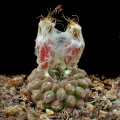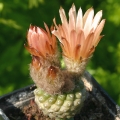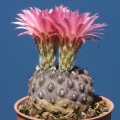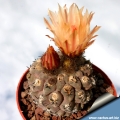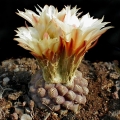




Your support is critical to our success.
Accepted Scientific Name: Eriosyce napina (Phil.) Katt.
Eriosyce (Cactac.) gen. revis. & ampl. (Succ. Pl. Res., 1) 118 (1994)
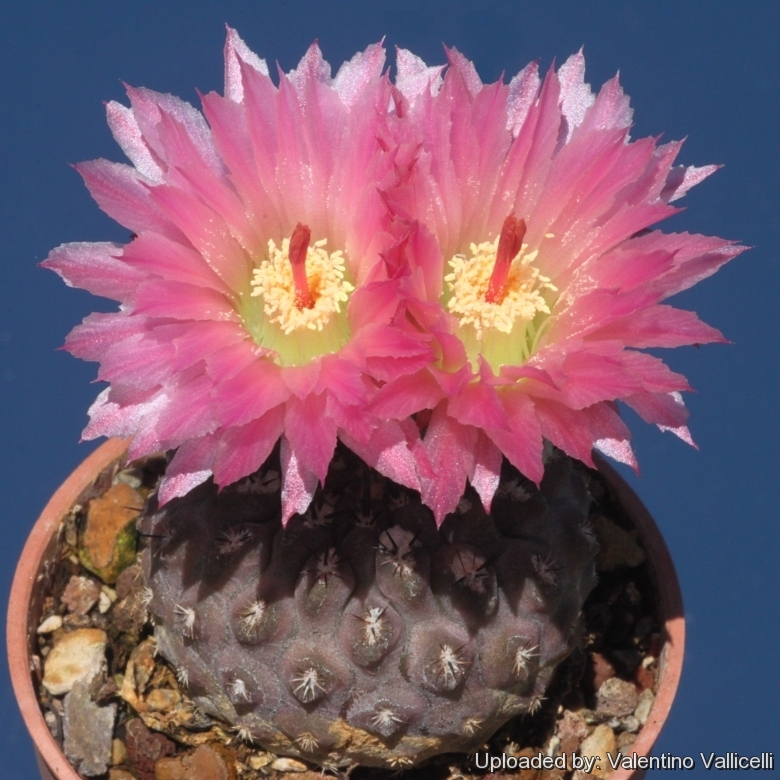
Origin and Habitat: From coastal Chile (Region III Atacama) South of Freirina in the Huasco valley (Atacama Desert)
Habitat: Eriosyce napinaSN|2370]]SN|2370]] grows in one of the most arid areas in the world, among rocky crags and sand dunes in sandy-clayey soil in a vegetable formation called “Costal desert of Huasco,” a typical “desertic mattoral” that is just spectacular and impressive when it displays the phenomenon of the “flowering desert”.
Altitude around 200 m.
Synonyms:
- Eriosyce napina (Phil.) Katt.
- Chilenia napina (Phil.) Backeb.
- Chileorebutia napina (Phil.) F.Ritter
- Echinocactus napinus Phil.
- Hildmannia napina (Phil.) Kreuz. & Buining
- Malacocarpus napinus Britton & Rose
- Neochilenia napina (Phil.) Backeb. ex Dölz
- Neochilenia napina (Phil.) Y.Itô
- Neoporteria napina (Phil.) Backeb.
- Notocactus napinus (Phil.) A.Berger
- Thelocephala napina (Phil.) Y.Itô
- Thelocephala roseiflora Y.Itô
Eriosyce napina (Phil.) Katt.
Eriosyce (Cactac.) gen. revis. & ampl. (Succ. Pl. Res., 1) 118 (1994)
Synonymy: 31
- Eriosyce napina (Phil.) Katt.
- Chilenia napina (Phil.) Backeb.
- Chileorebutia napina (Phil.) F.Ritter
- Echinocactus napinus Phil.
- Hildmannia napina (Phil.) Kreuz. & Buining
- Malacocarpus napinus Britton & Rose
- Neochilenia napina (Phil.) Backeb. ex Dölz
- Neochilenia napina (Phil.) Y.Itô
- Neoporteria napina (Phil.) Backeb.
- Notocactus napinus (Phil.) A.Berger
- Thelocephala napina (Phil.) Y.Itô
- Thelocephala roseiflora Y.Itô
- Eriosyce napina subs. challensis I.Schaub & Keim
- Thelocephala challensis (I.Schaub & Keim) Faúndez & Saldivia
- Eriosyce napina var. imitans (Backeb.) nov. comb. ined.
- Neochilenia imitans Backeb.
- Neoporteria reichei f. imitans (Backeb.) Donald
- Eriosyce napina var. mitis (Phil.) Donald & G.D.Rowley
- Echinocactus mitis Phil.
- Hildmannia mitis (Phil.) Kreuz. & Buining
- Neochilenia mitis (Phil.) Backeb.
- Neochilenia napina var. mitis (Phil.) Backeb. ex Dölz
- Neoporteria napina var. mitis (Phil.) Donald & G.D.Rowley
- Eriosyce napina var. neoreichei (Backeb.) nov. comb. ined.
- Neochilenia neoreichei Backeb.
- Neoporteria reichei f. neoreichei (Backeb.) Donald & G.D.Rowley
- Reicheocactus neoreichei (Backeb.) Backeb.
- Eriosyce napina var. spinosior (Backeb.) nov. comb. ined.
- Neochilenia napina var. spinosior Backeb.
- Neoporteria napina var. spinosior Backeb.
- Neoporteria napina f. spinosior (Backeb.) Donald & G.D.Rowley
Eriosyce napina var. duripulpa (F.Ritter) Katt.
Eriosyce (Cactac.) gen. revis. & ampl. (Succ. Pl. Res., 1) 118 (1994)
Synonymy: 8
- Eriosyce napina var. duripulpa (F.Ritter) Katt.
- Chileorebutia duripulpa F.Ritter
- Eriosyce duripulpa F.Ritter
- Eriosyce napina subs. duripulpa (F.Ritter) Katt.
- Neochilenia duripulpa (F.Ritter) Backeb.
- Neoporteria napina var. duripulpa (F.Ritter) A.E.Hoffm.
- Neoporteria reichei f. duripulpa (F.Ritter) Donald & G.D.Rowley
- Thelocephala duripulpa (F.Ritter) F.Ritter
Eriosyce napina var. fankhauseri (F.Ritter) Romulski
Kaktusy Inne 4(3): 131. 2007 ; cf. Repert. Pl. Succ. 58: 9. 2008
Synonymy: 4
- Eriosyce napina var. fankhauseri (F.Ritter) Romulski
- Eriosyce napina subs. fankhauseri (F.Ritter) Mächler & Helmut Walter
- Neoporteria napina var. fankhauseri (F.Ritter) A.E.Hoffm.
- Thelocephala fankhauseri F.Ritter
Eriosyce napina var. lembckei Katt.
Eriosyce (Cactac.) gen. revis. & ampl. (Succ. Pl. Res., 1) 118 (1994)
Synonymy: 7
- Eriosyce napina var. lembckei Katt.
- Eriosyce napina subs. lembckei Katt.
- Neochilenia lembckei Backeb.
- Neoporteria napina var. lembckei (Backeb.) A.E.Hoffm.
- Neoporteria reichei var. lembckei (Backeb.) Donald & G.D.Rowley
- Neoporteria reichei f. lembckei (Backeb.) Donald & G.D.Rowley
- Thelocephala lembckei (Backeb.) F.Ritter
Eriosyce napina var. riparia (Mächler & Helmut Walter) Romulski
Kaktusy Inne 4(3): 131. 2007 ; cf. Repert. Pl. Succ. 58: 9. 2008
Synonymy: 3
- Eriosyce napina var. riparia (Mächler & Helmut Walter) Romulski
- Eriosyce napina subs. riparia Mächler & Helmut Walter
- Thelocephala riparia (Mächler & Helmut Walter) Faúndez & Saldivia
Eriosyce napina var. tenebrica (F.Ritter) Romulski
Kaktusy Inne 4(3): 131. 2007 ; cf. Repert. Pl. Succ. 58: 9. 2008
Synonymy: 4
- Eriosyce napina var. tenebrica (F.Ritter) Romulski
- Eriosyce napina subs. tenebrica (F.Ritter) Ferryman
- Eriosyce tenebrica (F.Ritter) Katt.
- Thelocephala tenebrica F.Ritter
Eriosyce napina f. viridis
Description: Eriosyce napinaSN|2370]]SN|2370]] is a tiny geophyte, with a solitary spherical or flattened stem slowly growing atop a thick, underground taproot, with a constriction between the stem and the root, eventually becoming somewhat elongated in cultivation.
Stem: Slow growing, up to 3-5 cm across, 2-6 cm tall, ranging from green to brown, but more commonly with brown-olive-grey tones.
Tubercles: Larger than ssp. lembckei.
Areoles: Grey.
Spines: Very short black radials.
Roots: Forms a tuberous root system with (usually) a very large carrot-like root
Flower: Approx 3,5 cm long, 4-6 cm in diameter, whitish, yellowish, pinkish to pale brick-red with a silky shine, buds densely hairy with brown wool.
Fruits: Large, red, clavate, wrapped in white wool.
Blooming season: Flowers already when young, synchronised flowering of the whole plants takes place over one or two days, and they remain open for about three or four days. Blooms in late spring.
Subspecies, varieties, forms and cultivars of plants belonging to the Eriosyce napina group
 Eriosyce napina (Phil.) Katt.: Tiny geophyte, with a solitary sphericalstem slowly growing atop a thick, underground taproot, with a constriction between the stem and the root. Spines: short black, flattened against the stem surface. Distibution Huasco to 15 km south of Freirina.
Eriosyce napina (Phil.) Katt.: Tiny geophyte, with a solitary sphericalstem slowly growing atop a thick, underground taproot, with a constriction between the stem and the root. Spines: short black, flattened against the stem surface. Distibution Huasco to 15 km south of Freirina. Eriosyce napina subs. challensis I.Schaub & Keim: It appears white due to its very woolly areoles and addpressed spines that make it looks like a tiny hairy Epithelantha.
Eriosyce napina subs. challensis I.Schaub & Keim: It appears white due to its very woolly areoles and addpressed spines that make it looks like a tiny hairy Epithelantha. Eriosyce napina var. duripulpa (F.Ritter) Katt.: Plant with globose stems, small tubercles, and horn-colored spines. Distribution: Vallenar to Huasco.
Eriosyce napina var. duripulpa (F.Ritter) Katt.: Plant with globose stems, small tubercles, and horn-colored spines. Distribution: Vallenar to Huasco.- Eriosyce napina var. fankhauseri (F.Ritter) Romulski
 Eriosyce napina var. lembckei Katt.: It has small tubercles, stems that sometimes become elongate, and horn-colored spines.
Eriosyce napina var. lembckei Katt.: It has small tubercles, stems that sometimes become elongate, and horn-colored spines. Eriosyce napina var. mitis (Phil.) Donald & G.D.Rowley: it is a dwarf form with a brown body and short spines pressed flat against the stem.
Eriosyce napina var. mitis (Phil.) Donald & G.D.Rowley: it is a dwarf form with a brown body and short spines pressed flat against the stem. Eriosyce napina var. riparia (Mächler & Helmut Walter) Romulski: Distribution: Elqui, east of Trapiche.
Eriosyce napina var. riparia (Mächler & Helmut Walter) Romulski: Distribution: Elqui, east of Trapiche.  Eriosyce napina var. tenebrica (F.Ritter) Romulski: has dark greyish brown or greenish-black, spherical to flattened stems 2-4(-7) cm in diameter with a conical taproot. Distribution: valley of the Rio Choros.
Eriosyce napina var. tenebrica (F.Ritter) Romulski: has dark greyish brown or greenish-black, spherical to flattened stems 2-4(-7) cm in diameter with a conical taproot. Distribution: valley of the Rio Choros. Eriosyce napina f. viridis: only differs for the stem colour which is a bright grass green and not a dark tannish-brown. It is (presumably) a nursery selected form, sometime found in the trade.
Eriosyce napina f. viridis: only differs for the stem colour which is a bright grass green and not a dark tannish-brown. It is (presumably) a nursery selected form, sometime found in the trade.
Bibliography: Major references and further lectures
1) Edward Anderson “The Cactus family” Timber Press, Incorporated, 2001
2) Nathaniel Lord Britton, Joseph Nelson Rose “Cactaceae: Descriptions and Illustrations of Plants of the Cactus Family” vol. 4 The Carnegie Institution of Washington, Washington 1923
3) James Cullen, Sabina G. Knees, H. Suzanne Cubey "The European Garden Flora Flowering Plants: A Manual for the Identification of Plants Cultivated in Europe, Both Out-of-Doors and Under Glass" Cambridge University Press, 11/Aug/2011
4) David R Hunt; Nigel P Taylor; Graham Charles; International Cactaceae Systematics Group. "The New Cactus Lexicon" dh books, 2006 ISBN 0953813444, 9780953813445
5) Fred Kattermann "Eriosyce (Cactaceae): The Genus Revised and Amplified" David Hunt, 1994
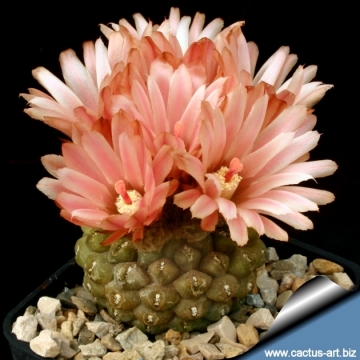
Field number: FR249 East of Huasco, Atacama, Chile, Date: 1954/05 (Eriosyce napina) Photo by: Cactus Art
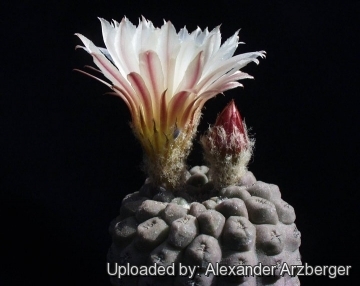
Thelocephala napina (Eriosyce napina) Photo by: Alexander Arzberger
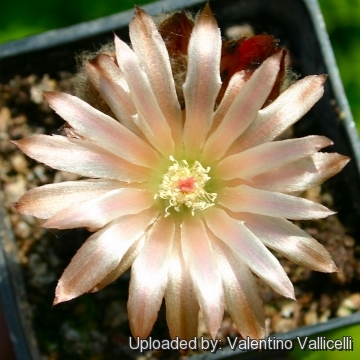
Thelocephala napina (Eriosyce napina) Photo by: Valentino Vallicelli
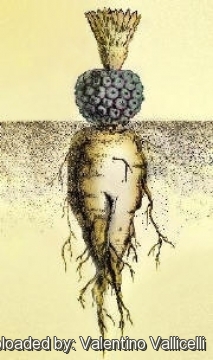
Thelocephala napina (Eriosyce napina) Photo by: Valentino Vallicelli
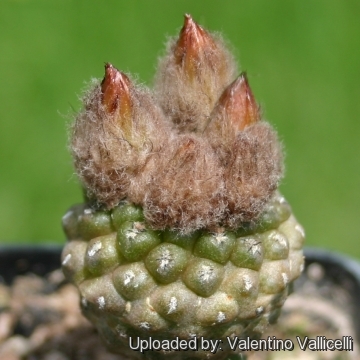
Thelocephala napina (Eriosyce napina) Photo by: Valentino Vallicelli
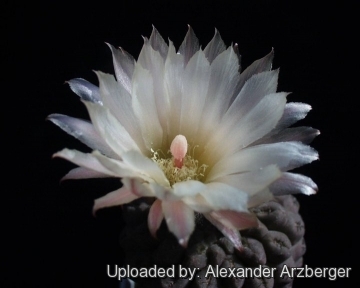
Thelocephala napina (Eriosyce napina) Photo by: Alexander Arzberger
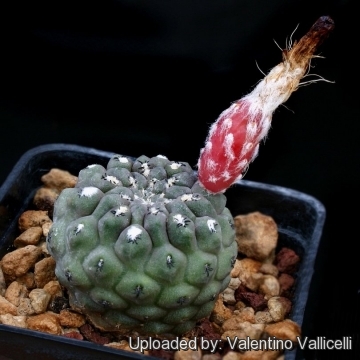
Thelocephala napina (Eriosyce napina) Photo by: Valentino Vallicelli
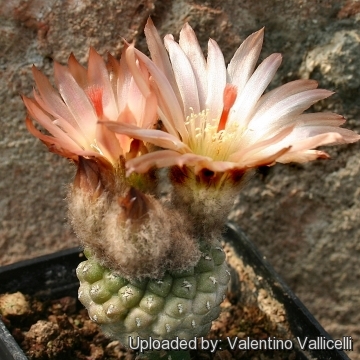
- Field number KK18a, Huasco, Chile 200m (Eriosyce napina) Photo by: Valentino Vallicelli
Cultivation and Propagation: It is a summer-growing species of relatively easy cultivation. This plant is extremely xerophytic and adapted to very dry soils. It has a thick taproot and is susceptible to over-watering if kept in a non ventilated place. This cactus continues to be, a particular prize among collectors.
Growth rate: Slow-growing.
Soil: Grow it in an open mineral, sandy-gritty cactus compost and provide a very good drainage. It needs deep pots to accommodate its taproot.
Exposure: It is suited for sunny-brightly exposure; can tolerate light shade and has a good heat tolerance. But it will do its best only with lots of sun and become stressed with inadequate light which could result in poor growth and unnatural shape.
Watering: Water in moderation, it prefer a completely dry place during winter. Mature individuals easily rot and die especially after planting so be extremely cautious with watering. Keep dry in winter or when night temperatures remain below 10° C. Water it less than average if in bigger pots.
Fertilization: Feed them once during the growing season with a fertilizer specifically formulated for cactus and succulents (high potash fertilizer with a dilute low nitrogen), including all micro nutrients and trace elements diluted to ½ the strength recommended on the label. They thrive in poor soils and need a limited supplies of fertilizer to avoid the plants developing excess vegetation, which is easily attacked by fungal diseases.
Special need: It is suited for airy exposures. Provide very good ventilation. Nearly all problems occur as a result of overwatering and poor ventilation, especially when weather conditions are dull and cool or very humid. They must have very dry atmosphere.
Hardiness: It likes warmth (recommended minimum winter temperature 5° C) But plants kept perfectly dry can easily survive to winter night temperatures below 0° C.
Pests & diseases: These cacti may be attractive to a variety of insects, but plants in good condition should be nearly pest-free, particularly if they are grown in a mineral potting-mix, with good exposure and ventilation. Nonetheless, there are several pests to watch for:
- Red spiders: Red spiders may be effectively rubbed up by misting the plants from above.
- Mealy bugs: Mealy bugs occasionally develop aerial into the new leaves and flowers with disfiguring results, but the worst types develop underground on the roots and are invisible except by their effects.
- Scales, thrips and aphids: These insects are rarely a problem.
- Rot: Eriosyce napinaSN|2370]]SN|2370]] is especially prone to rot, therefore, underpot in a smaller container filled with very porous compost. However root rot is only a minor problem if the plants are watered and “aired” correctly. If they are not, fungicides won't help all that much.
Propagation: Usually propagated from Seeds. (seldom produces offsets) or graft. The seeds can be sown in pots of fine, well-drained sandy soil, any time during the spring when temperatures are warm. Cover the seeds with a fine layer of grit and water from below with a fungicide to prevent damping off. For the 1-2 weeks cover the pots with a sheet of glass/clear perspex to keep the humidity levels high. Remove the glass and replace it with light shade-cloth and mist once or twice a day for the next two weeks after which most seeds should have germinated. From then on mistings can be reduced to every second and then every third day as the little plants grow. The seedlings should not be disturbed until they are well rooted after which they can be planted separately in small pots. Sometimes it is grafted to avoid root rot problems as plants grafted on an hardy stock are easy to grow and no special skill is required.
| Your Actions | |
|---|---|
| Back to Thelocephala index | |
| Back to Cactaceae index | |
 |
Back to Cacti Encyclopedia index |
Privacy stantement - Terms and conditions - How to cite - About us - Feedback - Donate




